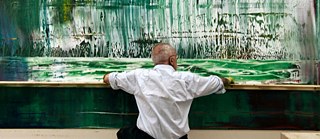Gerhard Richter Painting
A master at work

Gerhard Richter Painting is a film about method. Slowly, it challenges us to see action in the quotidian, and to think carefully and critically about the making of art.
By William Jameson
Shot between 2008 and 2009, filmmaker Corinna Belz follows the artist Gerhard Richter in his private studio in Cologne and to shows at the National Portrait Gallery in London and the Goodman Gallery in New York. The result, Gerhard Richter Painting, released in 2011, is an intimate portrait of an artist at work. What sets the film apart, indeed what makes it both an experiment and a success, is how well the film captures the act of creation, without overselling it with hype. Although Richter was 77 when the film was produced, it is not a life-long retrospective. Nor does it leverage drama with a chorus of rumors and outsider opinions. The film merely shows Richter working and thinking, closely following his preparation for his upcoming exhibits.
A Master at Work
Belz invites her audience to consider the daily artistic process. Long, uncut scenes of Richter painting are mixed with edited and elapsed shots of Richter peeling, scraping, and repainting his canvases. In the opening scene, Belz teaches Richter how to use the camera in his studio; his studio is listed as the “second camera studio” in the credits. This is a gesture of collaboration. Richter is the subject of study on one side of the camera, and a co-author of his story on the other.
While Richter paints, a conversational Q&A between him and Belz takes the shape of the film’s narrative. Belz asks the obvious questions any viewer might have, like what colors he chooses (classic colors, no earth tones), and what paint he uses for what. His assistants tell Belz that he uses a special paint for the abstracts, so he can apply it evenly with a large squeegee. After a long first pass on two brightly colored canvases, Belz asks if the paintings stay like this. Standing back, Richter says no. First they have to sit. “They’ll look good for two hours. Sometimes for a day,” he says. “Ultimately, they do what they want.”Painting as a Moral Act
Gerhard Richter was born in Dresden in 1932 and immigrated to West Germany, as a political refugee, in 1961. Because of his political status, he did not return home until 1987. By then, his family had died. The decision to paint in exile is important for Richter, and more than once he confirms that painting is a moral act. In a clever comparison, Belz samples footage from an interview at Atelier Düsseldorf in 1969 when Richter was asked similar questions. “Painting starts with one’s personal morality,” he says, “but being part of society, you’re not alone.” Later, Belz records an interview between Richter and the art historian, Benjamin Buchloh. “We’re all completely equal here,” Richter says, “the producer and consumer, artist and observer. Both must have one quality: to be able to see if it’s good or not. To be able to make that judgement.”This sensibility, to know whether or not a painting is good, is the essence of Belz’s film. As difficult as it might be, it is this very experiment that makes the film feel especially authentic. Richter tells us, “I don’t think I can do this. Painting under observation. It’s worse than being in the hospital. Painting is a secretive business anyways.”
American Enthusiasm
For Americans viewers, paying careful attention to Richter’s rhetoric gives us a unique insight into the differences between two cultures. Never bombastic, he is reluctant to oversimplify or overshare. “Americans are so enthusiastic,” Richter says. “And they aren’t shy to say what they think.” On Richter’s first gallery show in the U.S., at the Onnasch Gallery in 1972, he shares his surprise when American fans came up to him to tell him it was a great show. “Except for the grey ones,” they said. “Those are bullshit.”At the end of the day, Richter lets his art do the talking. “To talk about painting is not only difficult, but perhaps pointless, too,” he says. “You can only express in words what words are capable of expressing, what language can communicate. Painting has nothing to do with that.” For Richter, each painting must survive the test of time. Only paintings that “hold up” in the days and weeks after they’ve been painted are a success. In much the same way, Gerhard Richter Painting has aged well. It is a film that holds up.
author

William Jameson studied German at the University of Washington and at the International Culture Institute in Vienna. A graduate of the Iowa Writers' Workshop, he now lives in San Francisco.